Raton’s Unique Christmas Tradition
By Pat Veltri
As a lifelong resident of Raton, Frank Ferri values the city’s time-honored Christmas traditions. One tradition in particular, from the recent past, holds special meaning for him — the building of the town’s Christmas tree using live evergreen branches and a utility pole, and placing it in the median between Park and Clark Avenues. The tradition began for him at an early age and extended into his adult years when he actually had a hand in making the tree “come to life”.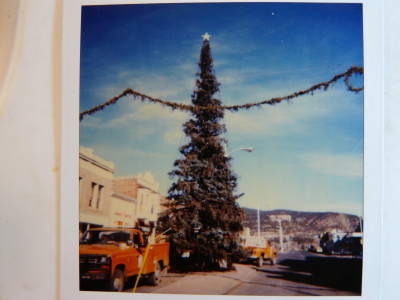
For decades the attention-grabbing “pole” tree dazzled generations of citizens and visitors alike. As a small child Ferri was awed by the sheer size of it. “When I was a kid, I can remember going by in the car and you couldn’t see the top of it until you got far away from it,” he says.
Ferri left Raton for a few years while serving a stint in the Navy. After returning to his hometown, he began his work with the Raton Public Service Company, the entity charged with the task of assembling and maintaining the tree, in addition to providing the electrical power for the thousands of lights adorning it. Ferri worked for RPS from 1972 until 2006 and held a myriad of jobs, including boiler operator, lead welder, and eventually assistant plant superintendent, but whenever the holidays rolled around, he was personally involved in the assembling of the tree.
Initially, back in 1935, when RPS began decorating the town for Christmas, live trees were used and over the years were situated in several different places. For example, in 1938, a 71-foot tree was placed on top of Goat Hill.
In 1947, in order to save time and money, RPS experimented with using a flag pole with several hundred holes strategically placed along its length. Branches were gathered and placed in the holes to form the tree. Archives of the local newspaper, The Raton Daily Range, reported that the RPS somehow came into possession of the pole from CampTrinidad, a World War II German prisoner of war camp, located near Trinidad, Colorado. Ferri says the flag pole was 70 or 80 feet long, and “eventually got cut down because it was too tall.” How the pole was delivered to Raton remains a mystery, but Ferri speculates that due to its size, it was probably brought by rail.
In time, after many years of use, the flag pole deteriorated and was replaced with a smaller utility pole. The Christmas pole tree tradition began to fade away in 1994 when city officials decided to move the tree from the median to RipleyPark because of safety concerns. In 2004, the “pole” tree was replaced with a live tree donated by Mary Lee Gabriele.
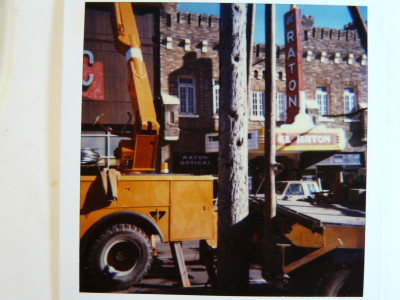 Traditionally, the tree, the lights and the other greens strung along the streets and avenues in downtown Raton begin to go up about a week before Thanksgiving, and are usually finished in time for the official lighting of the tree the day after Thanksgiving. Ferri remembers, “With the experienced crew that we had, we could build the tree and get all the greens up, wrapped, and put up in a week’s time. We had a good crew. Everybody had a job and it went pretty fast.”
Traditionally, the tree, the lights and the other greens strung along the streets and avenues in downtown Raton begin to go up about a week before Thanksgiving, and are usually finished in time for the official lighting of the tree the day after Thanksgiving. Ferri remembers, “With the experienced crew that we had, we could build the tree and get all the greens up, wrapped, and put up in a week’s time. We had a good crew. Everybody had a job and it went pretty fast.”
Ferri recalls that all of the evergreen branches used were gathered on Kaiser Steel property, with permission from company officials. “Most of the branches were pine,” he says, “but I’m sure there was some spruce and there could have been a little bit of cedar. We tried to keep it uniform with the same kind of greens.”
The combination of a skilled and competent crew, plus a well-established routine, allowed the tree to be easily assembled in a timely manner. The building of the tree started in front of the RPS warehouse. Ferri describes the process: “The guys had it hung with their boom trucks* and they would build their tree. They would get probably maybe half, maybe three quarters done, get it downtown and set it up with their boom trucks.” The pole was placed in a permanent holder, a six foot deep steel pipe casing located in the Second Street median between Park and Clark Avenues. He continues, “We had four or five linemen climbing up in the tree, and the rest of us would be on the ground handing limbs to them, measuring, trying to make it look uniform. They had a big ring up there that they would hook the stringers* on; it went all around the tree. The last thing they did was to put the star on top.” In time, the pole was cut down to about half its size which made it easier to work on, and the older model winch trucks were replaced with new bucket trucks that would reach all the way to the top of the tree, eliminating the need for the linemen to do any climbing to work on the top end of it.
The RPS crew carefully considered the well-being and protection of the public while the tree was being put together. Ferri says, “We normally had to get the police to come and block off the streets because we were out in traffic. We had our trucks out there and our cones, but some people would come whizzing by just a little too close. We finally got the city to arrange to put a cop on each end and divert the traffic around us until we got done, just for safety’s sake. We had to lay that tree across both sides of the street and then we had to stand it up; it was a little bit dangerous, but no one got hurt that I can recall. We were very careful because we didn’t want to hurt anybody in the public.”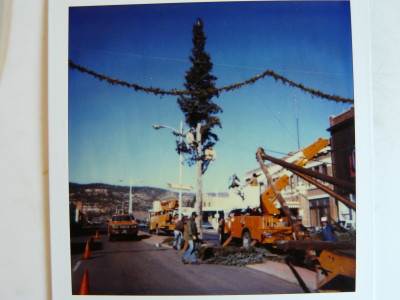
Traditions are fun. They make people smile. They create good memories. A memory that makes Ferri smile is his recollection of the earliest times he was involved in building the tree, when the pole was still close to full length and RPS was using a 1964 International boom truck. “The pole stuck way out behind that truck and we had our boom extended as far as it would go. We came out to the street by the front of the power plant and it (the pole) was heavy; of course we had the tree half way built. The truck had a big weight on it, but we still had to put a couple of guys on the truck bumper of that old truck to keep the wheels down so we could steer it. We felt kind of silly coming up the street but we always made it. It was a little bit scary but it was kind of fun. Everybody knew what was going to happen so we climbed on the front of it, and kept it from bouncing too much so we could get up Second Street.”

Ferri says that once the tree was up “it seemed to magically bring the Christmas spirit to life in Raton”. “What a magnificent sight, especially for the little ones,” he reminisces. “I used to tell everybody that only the good Lord and the RPS line crew could build such a perfect Christmas tree.”
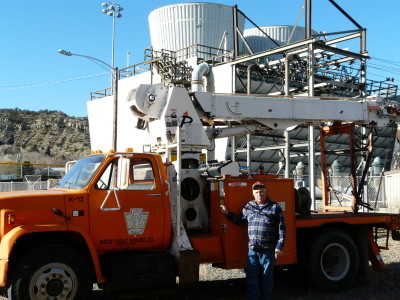
For several decades, while Raton was growing and changing, the tradition of building the Christmas tree offered consistency and gave people something to look forward to. In 1994 the long-lasting tradition was broken when the tree was moved from its usual position to RipleyPark because of traffic safety issues. The Christmas tree pole was retired in 2004, and a live tree was planted in the park to be used as Raton’s permanent Christmas tree. Ferri says, “When it got moved into the park, I was kind of disappointed because I thought it was really cool downtown. If you came into Raton from either the north or the south, as tall as that tree was, it caught your eye. This beautiful, gigantic Christmas tree with a star on top and stringers of blinking lights definitely got everybody’s attention. I hated to see it being moved because traditionally that’s just where it was. It just seems like that’s where it ought to be.”
*Boom Truck: A boom truck is a utility vehicle with an extendable arm mounted to a bed or roof.
*Stringers: Strings of lights

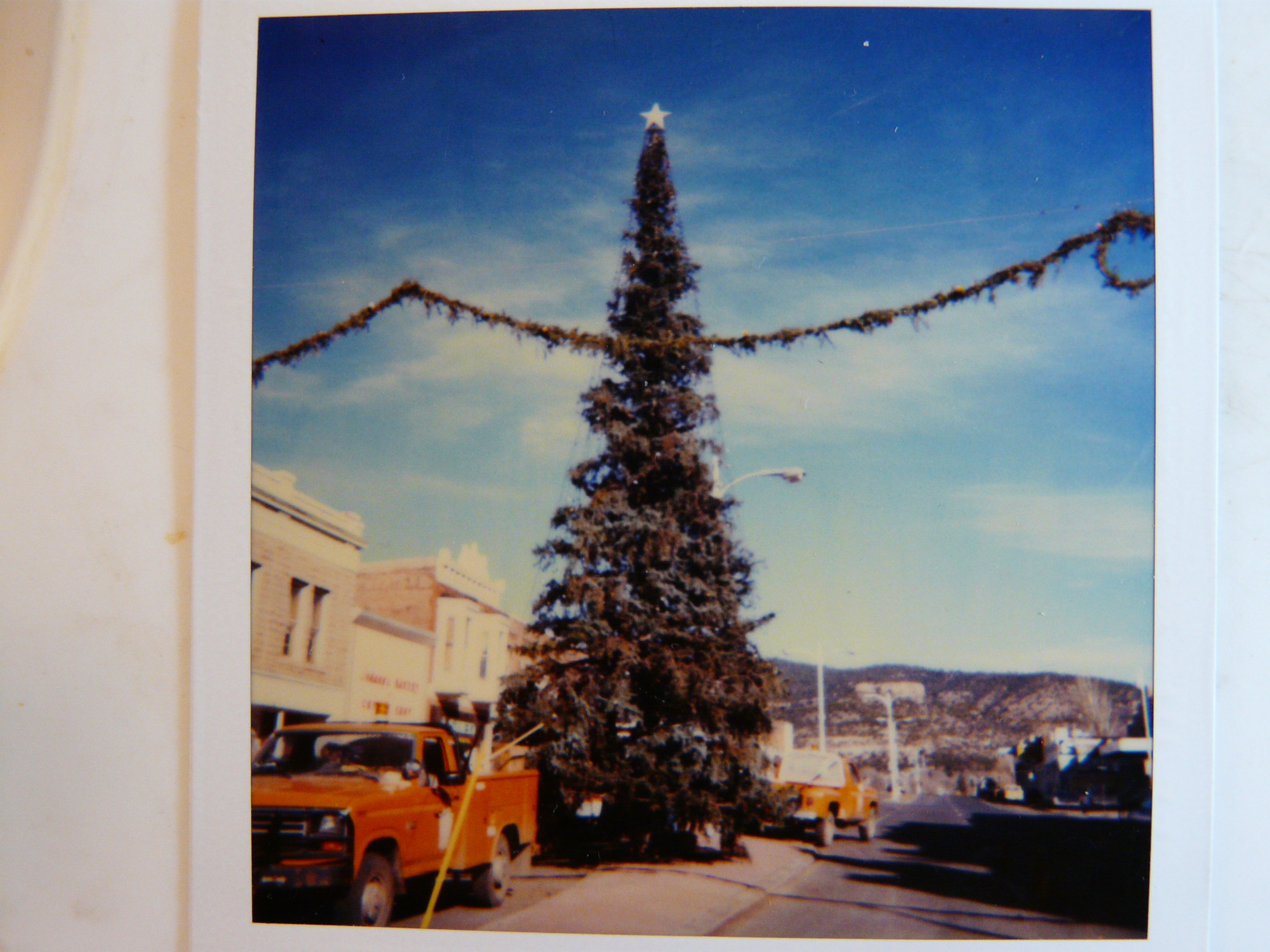
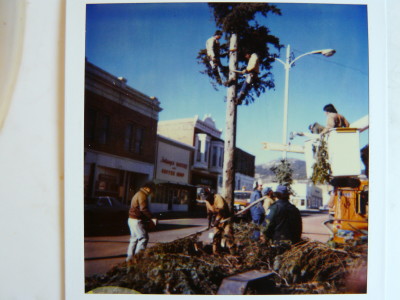

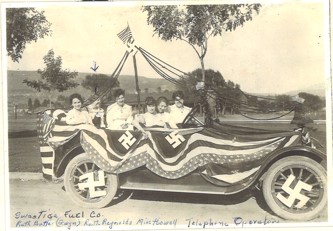


i grew up in raton and have not been back around Christmas for about 30 years sorry to hear that they moved the tree to the park. I just knew it was Chritmas time when you saw the tree in the middle of the street. I hate that we have to lose tradition just in case it might save one person from getting hurt.